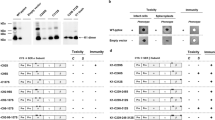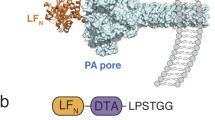Abstract
The cytoplasmic virus-like element pWR1A from Debaryomyces robertsiae encodes a toxin (DrT) with similarities to the Pichia acaciae killer toxin PaT, which acts by importing a toxin subunit (PaOrf2) with tRNA anticodon nuclease activity into target cells. As for PaT, loss of the tRNA methyltransferase Trm9 or overexpression of tRNAGln increases DrT resistance and the amount of tRNAGln is reduced upon toxin exposure or upon induced intracellular expression of the toxic DrT subunit gene DrORF3, indicating DrT and PaT to share the same in vivo target. Consistent with a specific tRNase activity of DrOrf3, the protein cleaves tRNAGln but not tRNAGlu in vitro. Heterologous cytoplasmic expression identified DrOrf5 as the DrT specific immunity factor; it confers resistance to exogenous DrT as well as to intracellular expression of DrOrf3 and prevents tRNA depletion by the latter. The PaT immunity factor PaOrf4, a homologue of DrOrf5 disables intracellular action of both toxins. However, the DrT protection level mediated by PaOrf4 is reduced compared to DrOrf5, implying a recognition mechanism for the cognate toxic subunit, leading to incomplete toxicity suppression of similar, but non-cognate toxic subunits.





Similar content being viewed by others
References
Chen C, Huang B, Anderson J, Byström AS (2011) Unexpected accumulation of ncm5U and ncm5S2U in a trm9 mutant suggests an additional step in the synthesis of mcm5U and mcm5S2U. PLoS One 6:e20783
Cong YS, Yarrow D, Li YY, Fukuhara H (1994) Linear DNA plasmids from Pichia etchellsii, Debaryomyces hansenii and Wingea robertsiae. Microbiology 140:1327–1335
Gunge N, Sakaguchi K (1981) Intergeneric transfer of deoxyribonucleic acid killer plasmids, pGKl1 and pGKl2, from Kluyveromyces lactis into Saccharomyces cerevisiae by cell fusion. J Bacteriol 147:155–160
Gunge N, Tamaru A, Ozawa F, Sakaguchi K (1981) Isolation and characterization of linear deoxyribonucleic acid plasmids from Kluyveromyces lactis and the plasmid-associated killer character. J Bacteriol 145:382–390
Hayman GT, Bolen BL (1991) Linear DNA plasmids of Pichia inositovora are associated with a novel killer toxin activity. Curr Genet 19:389–393
Hishinuma F, Hirai K (1991) Genome organization of the linear plasmid, pSKL, isolated from Saccharomyces kluyveri. Mol Gen Genet 226:97–106
Hishinuma F, Nakamura K, Hirai K, Nishizawa R, Gunge N, Maeda T (1984) Cloning and nucleotide sequence of the DNA killer plasmids from yeast. Nucleic Acids Res 12:l7581–l7597
Huang B, Johansson MJ, Byström AS (2005) An early step in wobble uridine tRNA modification requires the Elongator complex. RNA 11:424–436
Jablonowski D, Fichtner L, Martin VJ, Klassen R, Meinhardt F, Stark MJR, Schaffrath R (2001) Saccharomyces cerevisiae cell wall chitin, the potential Kluyveromyces lactis zymocin receptor. Yeast 18:1285–1299
Jeske S, Meinhardt F (2006) Autonomous cytoplasmic linear plasmid pPac1-1 of Pichia acaciae: molecular structure and expression studies. Yeast 23:476–486
Jeske S, Meinhardt F, Klassen R (2007) Extranuclear inheritance: virus-like DNA-elements in yeast. In: Esser K, Lüttge U, Beyschlag W, Murata J (eds) Progress in botany, vol 68. Springer, Berlin, Heidelberg, New York, pp 98–129
Kalhor HR, Clarke S (2003) Novel methyltransferase for modified uridine residues at the wobble position of tRNA. Mol Cell Biol 23:9283–9292
Kämper J, Meinhardt F, Gunge N, Esser K (1989) New recombinant linear DNA-elements derived from Kluyveromyces lactis killer plasmids. Nucleic Acids Res 17:1781
Kast A, Klassen R, Meinhardt F (2014) rRNA fragmentation induced by a yeast killer toxin. Mol Microbiol 91:606–617
Klassen R, Meinhardt F (2002) Linear plasmids pWR1A and pWR1B of the yeast Wingea robertsiae are associated with a killer phenotype. Plasmid 48:142–148
Klassen R, Meinhardt F (2003) Structural and functional analysis of the killer element pPin1-3 from Pichia inositovora. Mol Genet Genomics 270:190–199
Klassen R, Meinhardt F (2007) Linear protein-primed replicating plasmids in eukaryotic microbes. In: Meinhardt F, Klassen R (eds) Microbial linear plasmids, microbiology monographs, vol 7. Springer, Berlin, Heidelberg, pp 187–226
Klassen R, Tontsidou L, Larsen M, Meinhardt F (2001) Genome organization of the linear cytoplasmic element pPE1B from Pichia etchellsii. Yeast 18:953–961
Klassen R, Teichert S, Meinhardt F (2004) Novel yeast killer toxins provoke S-phase arrest and DNA damage checkpoint activation. Mol Microbiol 53:263–273
Klassen R, Krampe S, Meinhardt F (2007) Homologous recombination and the yKu70/80 complex exert opposite roles in resistance against the killer toxin from Pichia acaciae. DNA Repair (Amst) 6:1864–1875
Klassen R, Paluszynski JP, Wemhoff S, Pfeiffer A, Fricke J, Meinhardt F (2008a) The primary target of the killer toxin from Pichia acaciae is tRNA(Gln). Mol Microbiol 69:681–697
Klassen R, Fricke J, Pfeiffer A, Meinhardt F (2008b) A modified DNA isolation protocol for obtaining pure RT-PCR grade RNA. Biotechnol Lett 30:10401–10404
Larsen M, Meinhardt F (2000) Kluyveromyces lactis killer system: identification of a new gene encoded by pGKL2. Curr Genet 38:271–275
Lu J, Huang B, Esberg A, Johansson MJ, Bystrom AS (2005) The Kluyveromyces lactis γ-toxin targets tRNA anticodons. RNA 11:1648–1654
Meineke B, Kast A, Schwer B, Meinhardt F, Shuman S, Klassen R (2012) A fungal anticodon nuclease ribotoxin exploits a secondary cleavage site to evade tRNA repair. RNA 18:1716–1724
Paluszynski JP, Klassen R, Meinhardt F (2007) Pichia acaciae killer system: genetic analysis of toxin immunity. Appl Environ Microbiol 73:4373–4378
Satwika D, Klassen R, Meinhardt F (2012) Anticodon nuclease encoding virus like elements in yeast. Appl Microbiol Biotechnol 96:345–356
Schründer J, Gunge N, Meinhardt F (1996) Extranuclear expression of the bacterial xylose isomerase (xylA) and the UDP-glucose dehydrogenase (hasB) genes in yeast with Kluyveromyces lactis linear killer plasmids as vectors. Curr Microbiol 33:323–330
Studte P, Zink S, Jablonowski D, Bär C, von der Haar T, Tuite MF, Schaffrath R (2008) tRNA and protein methylase complexes mediate zymocin toxicity in yeast. Mol Microbiol 69:1266–1277
Tokunaga M, Wada N, Hishinuma F (1987) Expression and identification of immunity determinants on linear DNA killer plasmids pGKL1 and pGKL2 in Kluyveromyces lactis. Nucleic Acids Res 15:1031–1046
Tommasino M, Ricci S, Galeotti C (1988) Genome organization of the killer plasmid pGKL2 from Kluyveromyces lactis. Nucleic Acids Res 16:5863–5978
van Dijken JP, Bauer J, Brambilla L, Duboc P, Francois JM, Gancedo C, Giuseppin ML, Heijnen JJ, Hoare M, Lange HC, Madden EA, Niederberger P, Nielsen J, Parrou JL, Petit T, Porro D, Reuss M, van Riel N, Rizzi M, Steensma HY, Verrips CT, Vindelov J, Pronk JT (2000) An interlaboratory comparison of physiological and genetic properties of four Saccharomyces cerevisiae strains. Enzyme Microb Technol 26:706–714
Worsham PL, Bolen PL (1990) Killer toxin production in Pichia acaciae is associated with linear DNA plasmids. Curr Genet 18:77–80
Author information
Authors and Affiliations
Corresponding authors
Additional information
Communicated by S. Hohmann.
Rights and permissions
About this article
Cite this article
Klassen, R., Kast, A., Wünsche, G. et al. Immunity factors for two related tRNAGln targeting killer toxins distinguish cognate and non-cognate toxic subunits. Curr Genet 60, 213–222 (2014). https://doi.org/10.1007/s00294-014-0426-1
Received:
Revised:
Accepted:
Published:
Issue Date:
DOI: https://doi.org/10.1007/s00294-014-0426-1




